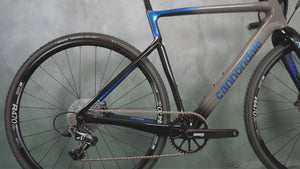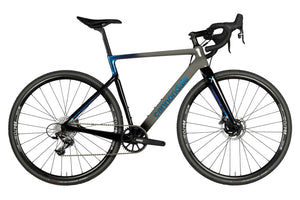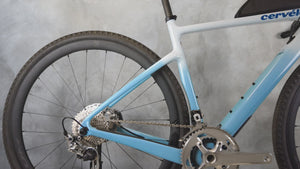Gravel / cyclo-cross: what are the differences?
In this Article
Published on October 5, 2023.
The differences between a gravel bike and a cyclo-cross bike are far from obvious! Similar overall appearance, wide, notched tires to adapt to any terrain... Yet on closer inspection, many details betray the more competitive nature of cyclocross 🧐
The boundary sometimes tends to blur a little since the emergence of a more performance-oriented gravel practice. In fact, since 2022, there has even been a world gravel championship! A world away from the original vocation of the gravel bike, which was based on reconnecting with nature, riding and travelling.
What are the differences between a gravel bike and a cyclo-cross bike? We take you to the muddy terrain to find out.
Are cyclocross and gravel the same thing?
CX - Gravel: the difference in approach

The main difference between cyclocross (also known as "CX") and gravel is first and foremost the almost opposite visions of these two disciplines. To understand this, we need to go back to the basics of both sports.
What is cyclo-cross? Practised in winter (and has been for a long time), this is a discipline in which riders compete over a short course (usually no more than 3 km). The route is technical and strewn with obstacles (stairs, embankments, ditches, artificial bridges, beams, sand, mud, rivers...).
It's very impressive to watch, but above all very, very intense to ride. You need to stay clear-headed and alert for about an hour at a sustained level of effort.
It's no wonder that the big names in cyclo-cross include Mathieu Van der Poel (5 times world champion), Wout Van Aert (3 times world champion) and Tom Pidcock (champion in 2020), to name but three!
Gravel is totally different! Invented much more recently, gravel involves using a bike adapted to (almost) any terrain. Visually, it's quite similar to a road bike, but more versatile.
👉In fact, if you'd like to find out more about the differences between road bikes and gravel bikes, we've covered the topic in this article.
The basic idea behind gravel biking is to have fun in the middle of nature, on gravel roads, trails and so on. Gravel is also the ideal partner for bikepacking or ultra-distance cycling. A totally different approach, based on pleasure, contact with nature and travel...
But, as we said in the introduction, gravel is now also seen as a competitive sport. The discipline's first world championships were held in 2022 (one of the few races where amateurs can mix with the pros if they qualify). Another sure sign is the appearance of aero gravels such as the 3T Exploro designed for performance and competition.
Nevertheless, gravel riding remains above all a sporting activity focused on relaxation.
Differences in equipment used
Once you understand the two distinct approaches, the differences between a gravel bike and a cyclocross bike seem logical. We'll tell you all about them right away.
Handlebars
Even if the shape seems identical, there will be differences in the width of the handlebars. Handlebar in particular.
The CX needs to be as narrow as possible in order to link up technical passages and slip between a barrier and a competitor. In cyclo-cross, we'll be using hangers similar to those used on the road, at around 400 mm.
Conversely, on a gravel bike, handlebars will be wide and flared for even greater maneuverability. So we'll be going beyond 440 mm for this type of bike.
The frame
Here again, gravel bikes are all about comfort and manoeuvrability, whereas cyclocross bikes are all about performance.
A gravel bike frame will therefore have a slightly longer wheelbase for comfort and stability. The overall geometry is also more rounded for greater flexibility. Finally, the crankset, while higher than on a road model, is lower than on a gravel bike because a priori you don't want to go over obstacles at high speed with this kind of bike.
The CX, on the other hand, will have a higher crankset for obstacles, but also to keep mud out of the bearings as much as possible. The higher center of gravity will bring instability, but also a nervousness that will enable rapid cornering.
The triangle of a cyclo-cross bike's frame will be larger to enable riders to place it quickly on the shoulder, for example when climbing stairs.
Last but not least, the wheel arch will be narrower, as wide tires are out of the question on a CX (more on that later).
In short, the cyclo-cross frame will enable you to go much faster, but it's much more technical to ride, and there's no room for error.
The weight
To go fast, jump an obstacle or be carried easily, cyclocross bikes need to be lighter, around 8 kg. Carbon is the preferred material for achieving this record weight.
Gravel bikes will be a little heavier, at least 9 kg for an average model. Except in the case of competition-type gravel bikes, frames are generally made of aluminum to enable heavy bikepacking panniers to be attached, for example.
Tires
With speed in mind, cyclo-cross tires are thinner, no more than 33 mm. That's slightly wider than on the road, of course (you still need a bit of surface area to ride in the mud). The special feature is that the tires are well notched on the edges of the tread to ensure maximum grip on the corner.
In gravel, we always think comfort, with tires up to 42 mm wide.
Developments
If you're going bikepacking on a gravel bike, you're likely to be carrying a heavy load. That's why you need a groupset that's easy to pedal. For example, you'll find wide cassettes ranging from 11 to 36 or even 46 teeth, coupled with 38 or 42-tooth chainrings. With this kind of development, you can tackle almost any slope!
The CX, on the other hand, is all about pushing hard on the pedals. At the front, we'll be using 36-46 or 38-48 double chainrings, rather 42 or 44 single chainrings. For the Cassettewill generally be around 11-28 or 11-32. Stronger developments to go faster, quite simply...
😉 Need help buying your used gravel? Follow the guide !
Are Gravel and Cyclo-Cross bikes interchangeable?

It's true that their favorite terrains are the same. But the major differences just mentioned make it impossible to use one for the other. Or at least not in the long term...
Can a gravel bike be used for cyclocross?
In theory, yes. There's nothing to stop you taking your frustration out on a cyclocross course with a gravel bike...
Of course, that's not the primary vocation of these bikes, so don't expect dazzling performance. Jumping a plank on a gravel bike weighing almost 10 kg is no easy feat. 😉
And you shouldn't repeat the exercise too often: gravels aren't designed to absorb all the shocks that cyclo-cross requires.
So if you want to have a bit of fun once in a while, fine. But it's not ideal...
Is a cyclocross bike good for gravel?
It all depends on what you mean by that.
If you want to ride on gravel roads or forest trails, you shouldn't have any trouble with a CX. But if you're planning to do long-distance and/or bikepacking, things are going to get a bit trickier.
Cyclo-cross races last 1 hour, sometimes a little longer. So these bikes aren't designed for very long rides. You'll soon find yourself uncomfortable on them. What's more, there's no provision for attaching panniers.
You can take a CX for a spin, but when it comes to long trips, it's best to avoid them.
Although they share the same playground and look very similar, cyclo-cross and gravel bikes are very different. And there's a good reason for this: they're two very different approaches to cycling.
The choice is yours! In any case, at The Cyclist House, cyclo-cross or gravel we've got everything you need!















